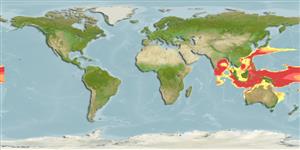Classification / Names
Noms communs | Synonymes | Catalog of Fishes(Genre, Espèce) | ITIS | CoL | WoRMS | Cloffa
>
Stomiiformes (Lightfishes and dragonfishes) >
Stomiidae (Barbeled dragonfishes) > Melanostomiinae
Etymology: Eustomias: Greek, eu = good + Greek, stoma = mouth (Ref. 45335); perplexus: From its perplexing combination of characteristics also found in longibarba and curtatus..
Environment: milieu / climate zone / depth range / distribution range
Écologie
marin; profondeur 0 - 2600 m (Ref. 11333). Tropical
Western Pacific: China and Papua New Guinea.
Taille / Poids / Âge
Maturity: Lm ? range ? - ? cm
Max length : 13.4 cm SL mâle / non sexé; (Ref. 11333); 14.7 cm SL (female)
Description synthétique
Morphologie | Morphométrie
Rayons mous dorsaux (Total): 24; Rayons mous anaux: 35; Vertèbres: 67. A single terminal bulb, its length more than twice its width, with a terminal projection that may be undeveloped or up to 55% of bulb length. Bulb and projection combined 0.8-2.2% SL. Barbel 67-83% SL, except in the smallest specimen. Axis of stem moderately to fairly dark pigmented proximally, becoming lighter or unpigmented distally. External chevron-shaped or roundish striated areas unpigmented, becoming closely spaced distally. Widely spaced spherical inclusions present in distal 1/3 to 1/2 of stem, sparse or absent before bulb. Middorsal paired spots between occiput and dorsal-fin origin 8, sometimes 9 (Ref. 11333).
Life cycle and mating behavior
Maturité | Reproduction | Frai | Œufs | Fécondité | Larves
Kailola, P.J., 1987. The fishes of Papua New Guinea. A revised and annotated checklist. Vol. 1. Myxinidae to Synbranchidae. Research Bulletin No. 41. Department of Fisheries and Marine Resources, Port Moresby, Papua New Guinea. 194 p. (Ref. 6993)
Statut dans la liste rouge de l'IUCN (Ref. 130435)
Menace pour l'homme
Harmless
Utilisations par l'homme
Plus d'informations
Noms communsSynonymesMétabolismePrédateursÉcotoxicologieReproductionMaturitéFraiRassemblement de ponteFéconditéŒufsDéveloppement de l'œuf
Taille/ÂgeCroissanceLongueur-poidsLongueur-longueurFréquences de longueursMorphométrieMorphologieLarvesDynamique des populations larvairesRecrutementAbondanceBRUVS
RéférencesAquacultureProfil d'aquacultureSouchesGénétiqueElectrophoresesHéritabilitéPathologiesTraitementNutrientsMass conversion
CollaborateursImagesStamps, Coins Misc.SonsCiguateraVitesseType de nageSurface branchialeOtolithesCerveauxVision
Outils
Articles particuliers
Télécharger en XML
Sources Internet
Estimates based on models
Preferred temperature (Ref.
123201): 4.4 - 10.7, mean 6.6 °C (based on 590 cells).
Phylogenetic diversity index (Ref.
82804): PD
50 = 0.5000 [Uniqueness, from 0.5 = low to 2.0 = high].
Bayesian length-weight: a=0.00302 (0.00117 - 0.00783), b=3.12 (2.89 - 3.35), in cm total length, based on LWR estimates for this (Sub)family-body shape (Ref.
93245).
Niveau trophique (Ref.
69278): 4.2 ±0.8 se; based on size and trophs of closest relatives
Résilience (Ref.
120179): Haut, temps minimum de doublement de population inférieur à 15 mois (Preliminary K or Fecundity.).
Fishing Vulnerability (Ref.
59153): Low vulnerability (10 of 100).
